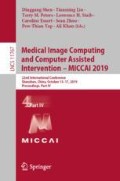Abstract
Automatic vertebrae recognition is crucial in spine diseases diagnosis, treatment planning, and response assessment. Although vertebrae detection has been studied for years, reliably recognizing vertebrae from arbitrary spine MRI images remains a challenge due to varying image characteristics, field of view (FOV) as well as vertebrae appearance. In this paper, we propose a Hierarchical Self-calibration Detection Framework (Hi-scene) to precisely recognize the labels and bounding boxes of all vertebrae in an arbitrary spine MRI image. Hi-scene is designed to first coarsely localize regions where vertebrae exist without the need of a priori knowledge about the scale, image characteristics and FOV; then accurately recognize vertebrae and automatically correct wrong recognitions by an elaborated self-calibration recognition network that embeds message passing into deep learning network. The method is trained and evaluated on a capacious and challenging dataset of 450 MRI scans, and the evaluation results show that our Hi-scene achieves high performance (testing accuracy reaches 0.933) from arbitrary input spine MRI and outperforms other state-of-the-art methods.
Access this chapter
Tax calculation will be finalised at checkout
Purchases are for personal use only
References
Liao, H., Mesfin, A., Luo, J.: Joint vertebrae identification and localization in spinal CT images by combining short-and long-range contextual information. IEEE Trans. Med. Imaging 37(5), 1266–1275 (2018)
Philip, F.: Patient Safety in Surgery. Springer, London (2014). https://doi.org/10.1007/978-1-4471-4369-7
Yang, D., et al.: Automatic vertebra labeling in large-scale 3D CT using deep image-to-image network with message passing and sparsity regularization. In: Niethammer, M., et al. (eds.) IPMI 2017. LNCS, vol. 10265, pp. 633–644. Springer, Cham (2017). https://doi.org/10.1007/978-3-319-59050-9_50
Lootus, M., Kadir, T., Zisserman, A.: Vertebrae detection and labelling in lumbar MR images. In: Yao, J., Klinder, T., Li, S. (eds.) Computational Methods and Clinical Applications for Spine Imaging. LNCVB, vol. 17, pp. 219–230. Springer, Cham (2014). https://doi.org/10.1007/978-3-319-07269-2_19
Chen, H., et al.: Automatic localization and identification of vertebrae in spine CT via a joint learning model with deep neural networks. In: Navab, N., Hornegger, J., Wells, W.M., Frangi, A.F. (eds.) MICCAI 2015. LNCS, vol. 9349, pp. 515–522. Springer, Cham (2015). https://doi.org/10.1007/978-3-319-24553-9_63
Glocker, B., Zikic, D., Konukoglu, E., Haynor, D.R., Criminisi, A.: Vertebrae localization in pathological spine CT via dense classification from sparse annotations. In: Mori, K., Sakuma, I., Sato, Y., Barillot, C., Navab, N. (eds.) MICCAI 2013. LNCS, vol. 8150, pp. 262–270. Springer, Heidelberg (2013). https://doi.org/10.1007/978-3-642-40763-5_33
Zhao, S., et al.: Robust segmentation of intima-media borders with different morphologies and dynamics during the cardiac cycle. IEEE J. Biomed. Health 22(5), 1571–1582 (2018)
Zhao, R., Liao, W., Zou, B., Chen, Z., Li, S.: Weakly-supervised simultaneous evidence identification and segmentation for automated glaucoma diagnosis. In: AAAI (2019)
Gao, Z., et al.: Robust estimation of carotid artery wall motion using the elasticity-based state-space approach. Med. Image Anal. 37, 1–21 (2017)
Ren, S., He, K., Girshick, R., Sun, J.: Faster R-CNN: towards real-time object detection with region proposal networks. In: NIPS, pp. 1–14 (2015)
He, K., Zhang, X., Ren, S., Sun, J.: Deep residual learning for image recognition. In: CVPR, pp. 770–778 (2016)
Lin, T., Dollar, P., Girshick, R., He, K., Hariharan, B., Belon, S.: Feature pyramid networks for object detection. In: CVPR, pp. 2117–2125 (2017)
Yedidia, J., Freeman, W., Weiss, Y.: Understanding belief propagation and its generalizations. Exploring Artif. Intell. New Millennium 8, 236–239 (2003)
Everingham, M., Van, G., Williams, C., Winn, J., Zisserman, A.: The pascal visual object classes (VOC) challenge. Int. J. Comput. Vis. 88(2), 303–338 (2010)
Author information
Authors and Affiliations
Corresponding author
Editor information
Editors and Affiliations
Rights and permissions
Copyright information
© 2019 Springer Nature Switzerland AG
About this paper
Cite this paper
Zhao, S., Wu, X., Chen, B., Li, S. (2019). Automatic Vertebrae Recognition from Arbitrary Spine MRI Images by a Hierarchical Self-calibration Detection Framework. In: Shen, D., et al. Medical Image Computing and Computer Assisted Intervention – MICCAI 2019. MICCAI 2019. Lecture Notes in Computer Science(), vol 11767. Springer, Cham. https://doi.org/10.1007/978-3-030-32251-9_35
Download citation
DOI: https://doi.org/10.1007/978-3-030-32251-9_35
Published:
Publisher Name: Springer, Cham
Print ISBN: 978-3-030-32250-2
Online ISBN: 978-3-030-32251-9
eBook Packages: Computer ScienceComputer Science (R0)


